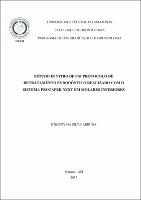| ???jsp.display-item.social.title??? |


|
Please use this identifier to cite or link to this item:
https://tede.ufam.edu.br/handle/tede/5767| ???metadata.dc.type???: | Dissertação |
| Title: | Estudo in vitro de um protocolo de retratamento endodôntico realizado com o Sistema Protaper Next em molares inferiores |
| ???metadata.dc.creator???: | Arruda, Etienny da Silva  |
| ???metadata.dc.contributor.advisor1???: | Marques, André Augusto Franco |
| ???metadata.dc.description.resumo???: | O objetivo do presente estudo foi avaliar a viabilidade de um protocolo de retratamento endodôntico, utilizando instrumentos Protaper Next, avaliando a ocorrência de transporte apical em raízes mesiais curvas de molares inferiores. Foram selecionados 40 molares inferiores com grau de curvatura da raiz mesial de aproximadamente 30° e raio de curvatura menor ou igual a 10 mm. Com o auxílio de instrumentos tipo K #10, avaliou-se a presença de forames independentes. Com o objetivo de padronizar o as amostras, as coroas foram parcialmente seccionadas em 16 mm e todos os corpos de prova foram inseridos em blocos de resina, para padronização das tomografias na mesma posição antes, durante e após a instrumentação e retratamento. Também foram submetidas ao mesmo processo de instrumentação e obturação, e só depois foram separadas aleatoriamente (n=10) em quatro grupos experimentais: Grupo Protaper Universal (PTU), no qual o instrumento utilizado para a remoção da gutta-percha era a Protaper F2 – 25.08; Grupo Reciproc e Grupo Protaper Next X2 onde para a mesma finalidade eram empregados os instrumentos Reciproc R25 – 25.08 e Protaper Next X2 – 25.06, respectivamente; e o Grupo Protaper Next X3, onde eram utilizados sequencialmente os instrumentos X2 para a remoção da gutta-percha e o X3 (30.07) para remodelação do canal, ambos pertencentes ao sistema Protaper Next. A análise do desvio apical se deu pela aplicação de fórmulas aos valores obtidos antes e após a instrumentação e com os dados obtidos também foi possível analisar o índice de centralização dos intrumentos bem como o aumento percentual da área proporcionado por eles. Os dados obtidos foram submetidos a testes de Kruskall-Wallis e teste de Múltiplas Comparações de Dunn. Os resultados do desvio apical não mostraram diferenças significantes entre os grupos avaliados (p < 0,05). Com base na metodologia empregada e nos resultados obtidos, concluiu-se que não houve, entre os grupos experimentais, diferença significante em relação à produção de desvio apical. |
| Abstract: | The purpose of this study was to evaluate a protocol for endodontic retreatment, using Protaper Next instruments, to evaluate the occurrence of apical transportation using CT. To perform the experiment, 40 mandibular molars were selected, with mesial root canal curvature between 30° and canal curvature radius less than or equal to 10 mm. Size 10 K-type instruments were used to determine the presence of independent foramen. In order to standardize the samples, the crowns were partially sectioned in 16 mm and all the specimens were inserted in resin blocks, to standardize the tomographies in the same position before, during and after instrumentation and retreatment. They were also submitted to the same instrumentation and obturation process, and were then randomly separated (n = 10) into four experimental groups: PTU group, in which the instrument used to remove gutta-percha was Protaper F2 (25.08); Group R25 and Group X2 where the Reciproc - R25 (25.08) and Protaper Next - X2 (25.06) instruments were used for the same purpose, respectively; And Group X3, where the X2 instruments were used sequentially for the removal of gutta-percha and X3 (30.07) for channel remodeling, both belonging to the Protaper Next system. Apical deviation was assessed by applying formulas to values obtained before and after instrumentation, and with the data obtained it was also possible to analyze centering ratio and percentual area increase. Data were subjected to the Kruskal-Wallis Test and the Dunn Multiple Comparisons Test. The results of the apical deviation presented no significant difference between the experimental groups (p <0.05). The methodology and the results lead to the conclusion that the experimental groups did not produce a statistically significant difference in apical deviation. |
| Keywords: | Endodontia Retratamento Transporte Apical Protaper Next |
| ???metadata.dc.subject.cnpq???: | CIÊNCIAS DA SAÚDE: ODONTOLOGIA |
| Language: | por |
| ???metadata.dc.publisher.country???: | Brasil |
| Publisher: | Universidade Federal do Amazonas |
| ???metadata.dc.publisher.initials???: | UFAM |
| ???metadata.dc.publisher.department???: | Faculdade de Odontologia |
| ???metadata.dc.publisher.program???: | Programa de Pós-graduação em Odontologia |
| Citation: | ARRUDA, Etienny da Silva. Estudo in vitro de um protocolo de retratamento endodôntico realizado com o Sistema Protaper Next em molares inferiores. 2017. 49 f. Dissertação (Mestrado em Odontologia) - Universidade Federal do Amazonas, Manaus, 2017. |
| ???metadata.dc.rights???: | Acesso Aberto |
| ???metadata.dc.rights.uri???: | http://creativecommons.org/licenses/by-nc-nd/4.0/ |
| URI: | http://tede.ufam.edu.br/handle/tede/5767 |
| Issue Date: | 12-Apr-2017 |
| Appears in Collections: | Mestrado em Odontologia |
Files in This Item:
| File | Description | Size | Format | |
|---|---|---|---|---|
| Dissertação - Etienny S. Arruda.pdf | 1.01 MB | Adobe PDF |  Download/Open Preview |
This item is licensed under a Creative Commons License





